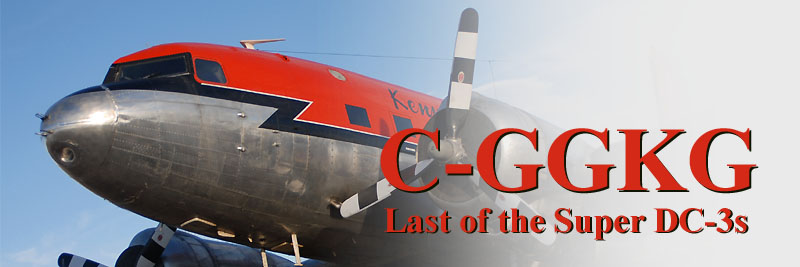
Airdrie, AB, Canada - September 2006

Called "the plane that changed the world" the Douglas DC-3 is undoubtedly the most respected aircraft in man's first century of flight. Built at the end of the great
depression, the Douglas combined modern construction and comforts with a touch of art-deco styling. Nearly 13,000 DC-3s (and military derivatives) were built for, and operated
by, military and civilian customers around the globe. (Trevor McTavish)

There was a period in Canadian history when hundreds of DC-3s could be found in Canada - the airlines operated them, freight companies used them, and the Air Force kept
its own fleet for a wide assortment of tasks. But sadly those days have faded and the ancient workhorses that once built the Canadian North have slowly disappeared. (Trevor
McTavish)

Originally built as just another DC-3 for the US Army, this plane was designated as a C-47A (or more correctly as a DC-3A-456) and assigned its military identity as
42-24345. Shortly afterwards it was transferred to the US Navy as an R4D-5. Again, its identity changed to bring it into line with the Navy's bureau number system, becoming Bu.
39080. (Trevor McTavish)

When Douglas offered an upgraded version of the DC-3, known as the Super DC-3, it quickly proved a commercial failure. Despite its superior performance, increased payload
and cabin pressurization, civilian operators simply couldn't justify the high cost of a Super DC-3 when compared to war surplus C-47s. Airlines, usually receptive to modern
equipment, also passed on the Super DC-3 because now their passengers wanted pressurization and tricycle landing gear. It was the US Navy that came to Douglas' rescue and bought
production space. (Trevor McTavish)

39080 was sent to Douglas for conversion, becoming an R4D-8. In 1962 the Navy dropped the R4D-8 designation in favor of a standardized C-117D (C stood for Cargo). (Trevor
McTavish)

After its retirement, 39080 was purchased by an American dealer and entered onto the civil registry. N2071X didn't last long because in March 1984 it was purchased by
Carl Millard of Toronto, Ontario. Millard operated a freight business hauling automobile parts in a collection of Douglas C-47s, C-117s and C-54s. Arriving in Ontario the plane
still wore its Navy markings, with the Canadian registration, C-GGKG temporarily affixed. (Trevor McTavish)

It was in the early part of the 1990s that Millardair closed its doors. After a solid decade of hard work in Southern Ontario 'GKG was offered for sale. Calgary based
Kenn Borek Air Ltd. purchased the plane for use on a contract with Adventure Network International. This company operated tourist flights in parts of the Antarctic, a location
where the DC-3 had already proven itself. (Trevor McTavish)

Upon its return to Canada 'GKG headed north to the remote community of Inuvik where another contractor, Aklak Air, had need for a freighter larger than the Twin Otter.
Since then Kenn Borek has been keeping the Super DC-3 operating throughout the Western Arctic, hauling freight and competing with its older, slower brothers - the C-47. (Trevor
McTavish)

The summer of 2006 was the swan song for 'GKG. Kenn Borek's new Basler Turbo DC-3 had concluded a very successful season throughout both the Western and Eastern Arctic.
And unlike the radial powered Super DC-3, the new Basler plane used the same Pratt & Whitney PT6 engines as the company's Twin Otters and King Airs. When photographed at the end
of September the Super DC-3 had already been parked in Airdrie and advertised for sale. (Trevor McTavish)

As it happens, C-GGKG was sold to Transnorthern Airlines in Anchorage, Alaska. She arrived there in June 2007 and has remained in service still wearing the red and black
paint scheme of Kenn Borek Air, although she now has the identity of N28TN. (Trevor McTavish)